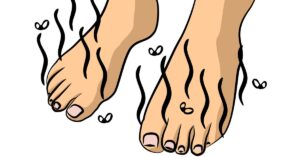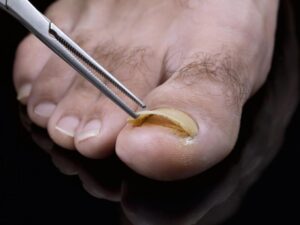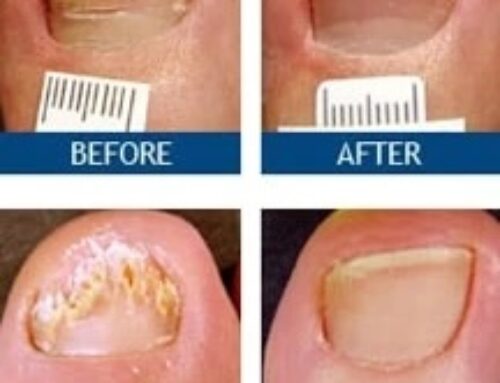Smell from toenail fungus infection can be a common symptom, especially when left untreated. It is important to have good foot hygiene to keep the toenail fungus infection from spreading. If you want to get rid of the stubborn toenail fungus infection, you should seek help from a foot doctor. Here at Laser Nail Therapy we offer free consultations where you can discuss treatment options.
What is it?
Toenail fungus or Onychomycosis usually causes the toenails to smell like cheese. The unpleasant odor is caused by the organism, tinea unguium. Other symptoms of toenail fungus include discoloration and brittleness of the toenail. This condition is common in people who wear closed shoes for long periods of time. The feet are unable to breathe and become sweaty. This becomes the perfect environment for fungus to grow. The fungus thrives in dark and damp environments. It can be worse when you do not wear socks.
What causes the smell?
If you have a smelly toenail problem, you may not even know what is actually causing it. Nail fungus is one of the most common causes of smelly toenails. The fungal spores infect the nail bed and use this bed to grow their colonies. Fungal growth occurs when fungal spores from the environment come into contact with the nail and attach to the nail bed. After the initial attachment has formed, some people will develop a full-fledged infection more quickly. This is particularly more common with people who wear closed-toed shoes, exercise frequently, or sweat excessively. Fungus loves dark, moist, humid environments; sweaty shoes are perfect for them.

What should you do first if you have smelly toenails?
The first thing to do when you have a smelly toenail problem is to identify the cause of the issue. If you can’t wait to get an appointment with a doctor, there are some signs you can look for. If the smell is coming directly from the toenails, this is one indication that the root cause is fungal. Fungal spores infect the nail bed, which is the area under the toenail. These fungal spores are associated with the bad smell that comes from toenail fungus.
It makes sense that the associated smell would come directly from the toenails as well. Fungal growth is not dependent on cleanliness and actually develops when a fungal spore from the outside environment attaches to the nail bed. While the initial attachment of the fungus to the nails can happen to anyone, certain behaviors and pre-existing conditions make the development of a more serious infection more probable. People who exercise a lot are especially prone to fungal infections since their feet tend to be sweaty and moist. Sweaty and moist environments are the perfect places for fungal spores to grow.
What happens if you don’t receive treatment for a toenail fungus infection?
If left untreated, a smelly toenail fungus infection will only continue to worsen over time. You need to receive a proper medical diagnosis from a licensed podiatrist if you want any results to show. One of the most important things about the treatment you receive is that it needs to be FDA-approved. This qualification ensures that the treatment you receive has been researched and proven to have some efficacy in dealing with the fungus.
DIY, at-home treatments for fungus are some of the treatments that aren’t FDA-approved; these treatments are always very ineffective and unlikely to have many positive effects on your condition. Some at-home treatments can actually cause serious harm to the nail and skin around it, for example, the dangerous recommendation from online sources to put bleach on your toenail fungus. Seeking a licensed medical professional, in particular a podiatrist, to give you an effective treatment is a much better option. A medical professional can both diagnose your condition and work with you to develop a treatment plan that will actually help.
Treatment options for toenail fungus
If you do find yourself with a toenail fungus infection, there are several treatment options recommended by foot doctors. Here are some of the common approaches:
- Topical treatments: Over-the-counter creams can help prevent toenail fungal infections. However, they are not very effective for treating an active infection and have a success rate of less than 10%. These creams are most useful as preventive measures or for mild cases of toenail fungus.
- Oral antifungal medication: Medications are commonly prescribed for more severe cases of toenail fungus. However, they come with potential side effects, including liver toxicity. Routine blood testing to monitor your liver are necessary during the course of treatment, and the average cure rate is only around 60%.
- Laser treatment: The most advanced option for toenail fungus treatment is laser therapy. Laser treatment offers a non-invasive and effective approach to eliminating toenail fungus. Various lasers are available, with differing success rates and FDA approvals. The PinPointe laser treatment, approved by the FDA, is a highly effective option, typically requiring only one session and offering no downtime or pain. It targets the fungus directly, penetrating the nail and killing the infection at its source.
For toenail fungus treatment, we highly recommend the PinPointe Laser as it boasts the highest cure rate in the market. It has no side effects, can go about your daily activities right after, and is a painless procedure.
Schedule a Consultation
If you have any signs of toenail fungus, don’t wait. Our nail doctors offer the PinPointe laser treatment, the most effective and safe method for curing toenail fungus. Call us today at (800) 672-0625 or visit our website to schedule a free consultation at a location near you.






